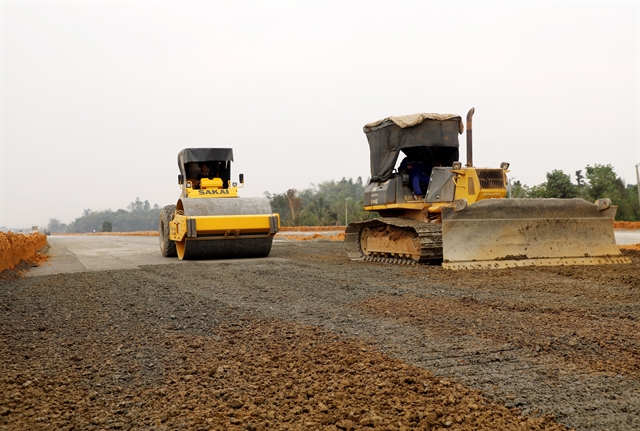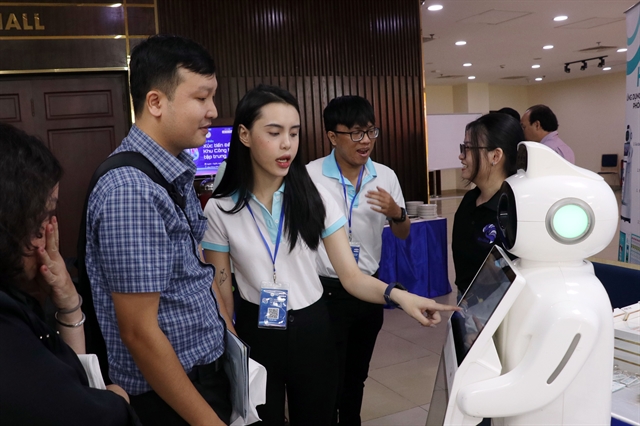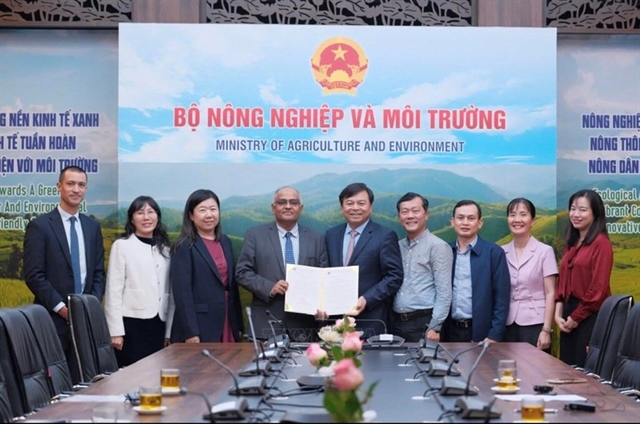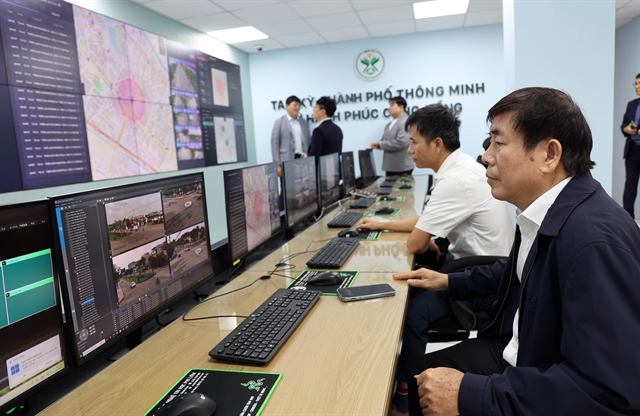 Society
Society

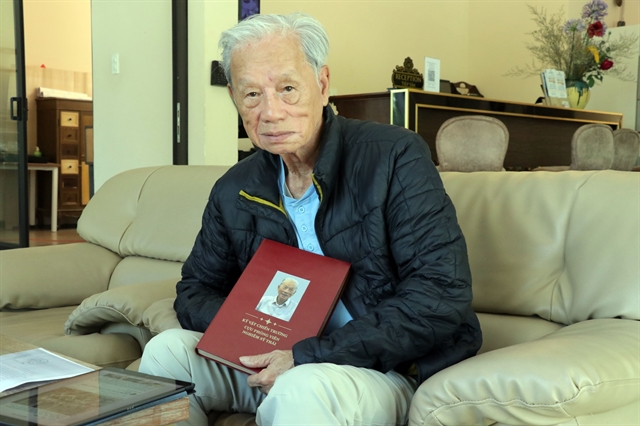 |
| Nghiêm Sỹ Thái receives the copy of his diary his wrote during war time, a journal which had been lost for 60 years. VNA/VNS Photo |
HÀ NỘI – Nghiêm Sỹ Thái is still overwhelmed with surprise after unexpectedly receiving a diary he had lost during his time as a frontline reporter on the Bình Trị Thiên battlefield.
The diary, long thought lost, was returned to him by the US Embassy on April 18.
A memento returns after nearly 60 years
Thái, 83, born in Đức Thọ District, central Hà Tĩnh Province, now resides in Đà Lạt city, is a veteran war reporter for the Liberation News Agency (now Vietnam News Agency). Earlier this month, one of his friends, a former lecturer at the Hà Nội University, where Thái once studied, suddenly called to ask whether he had ever lost a diary during the war.
Thái was stunned, as the event had happened so long ago and was known to very few people.
Then he became so joyful, learning that his diary, recording his student years and times as a battlefield reporter, lost decades ago, had been found.
'The other side' had retrieved it and was preparing to return it before the April 30, 2025 anniversary.
As Thái recalled each memory line by line, he reminisced about his youthful days as a student in Literature Class 3, Academy Year 7, at the Hà Nội University.
On May 10, 1965, after being granted early graduation, Thái and 12 classmates underwent journalism training to prepare for assignments in the 'Southern battlefield'.
“The students underwent three months of intensive training in news writing for the press agency, while I also requested two extra months to study photography,” Thái said.
On the war-torn Bình Trị Thiên battlefield, amid constant bombardments, he maintained the habit of recording daily life in a personal diary, while technical notes for work were kept in a separate notebook.
In late 1968, Thái volunteered to join the high-intensity Trị Thiên Campaign 935 for more reporting and photography opportunities.
Before departing, he entrusted the diary to Colonel Võ Hạp, head of Logistics of the military zone, saying: “I do not know if I will survive this campaign. Please keep this for me in case journalists and writers need reference material.”
However, upon returning, he found the area where the logistics post had been completely flattened by US bombs. All materials stored in the metal cabinets were lost, and the colonel’s assistant, who had kept the diary, had been killed.
“It was a great loss, but what could I do. It was war,” he consoled himself.
After receiving information that his lost diary had resurfaced, Thái eagerly awaited further updates.
Officers from the Lâm Đồng Provincial Military Command came to his house to verify the details.
On April 17, the unit arranged transport to HCM City so he could attend a ceremony for the handover of war memorabilia provided by the United States.
The event was organised by the 7th Military Region's Steering Committee 515 and the Office of the US Defence Attaché in Hà Nội.
The items returned included valuable documents such as commendations, battlefield diaries and notebooks belonging to veterans Hồ Văn Răng, Nghiêm Sỹ Thái, Vương Văn Lễ and martyrs Nguyễn Thị Ro, Dương Thi, Nguyễn Phước Chính, Nguyễn Văn Đạo, Nguyễn Thị Mến, Dương Ngọc Bửu, and Lê Tấn Đức.
At the handover ceremony, Thái said: “I truly never thought I would see my notebook again. Today, this precious item has returned to me, like ‘a lost pearl coming home’.
“To me, it is not just a keepsake, but a piece of memory, a part of my very flesh and blood,” the veteran journalist said.
Fierce war memories
 |
| After receiving the diary, he spends time every day reminiscing about his youth. VNA/VNS Photo |
The diary, like an old companion, is a source of solace. Thái now spends much of his time every day reminiscing about his student days and the intense moments when, with notebook and camera in hand, he roamed the smoke-filled Bình Trị Thiên battlefield, producing hundreds of reports, stories, and photographs amid the tragedy and heroism.
 |
| A page of Thái's diary. VNA/VNS Photo |
One diary entry reads: “July 19: Met five soldiers in a shack on the way to Quảng Trị, all had just recovered from malaria, poor lads. I gave them a few cigarettes and some lumps of salt. They were ecstatic, as these items are impossible to find here. The locals’ lives are also extremely difficult. Their meals mostly consist of wild vegetables cooked with a little salt—the salt stinks, and the greens are like pig feed back home, terribly hard to eat…”
“February 4: Walked all day, only leeches everywhere. The leeches here are like a fierce enemy, swarming the moment you stop. At first, we tried catching them, but later we were too exhausted to bother. On reaching our rest point, everyone rolled up their trousers to scrape them off. Some leeches hit blood vessels and caused heavy bleeding—it felt like being wounded by shrapnel…”
“March 21: Took four hours to cross Route 9. The liaison officers could cross easily, but we struggled. The real hardship wasn’t carrying thirty kilogrammes of gear, but crossing the Ba Lòng River at night in a boat. On the far bank, everyone was so tired they wanted to rest, but the liaison urged us to keep moving. In the end, we hid in an abandoned village once inhabited by ethnic minorities. Shortly after, enemy artillery shelled the village directly. We all scrambled to hide under rocks in a stream—thankfully, no one was injured…”
The last page of the diary is dated the second day of Tết (Lunar New Year) in 1967, but many words are faded or smudged—possibly due to damage or poor reproduction, (Thái just received a copy of the diary, as the original is archived by the US Government).
He recalled that the writing was about Tết celebrations among villagers living near the battlefront in Cổ Bi Hamlet, Phong An Commune. When locals saw a journalist from the North arrive to take photos, they were elated.
“A woman even chased after me to get a closer look at 'a Northerner'. She gifted me a can of condensed milk — a rare luxury in the war zone — while others offered bánh tét and giò (sticky rice and white rice dough dumpling) so I could take some back to the forest base,” he said.
This showed the deep affection locals had for revolutionary journalists and cadres, despite the daily hardships and mortal danger they faced.
Throughout the perilous years of wartime reporting, with death always near, Thái and his colleagues from the Liberation News Agency remained embedded in the battlefield, tirelessly fulfilling their reporting duties.
Thái held positions such as Chief of the Liberation News Agency Bureau in Thừa Thiên – Huế and later in Lâm Đồng Province under the Việt Nam News Agency.
 |
| Thái (front right) with his fellows on the battlefield of Bình Trị Thiên những in 1965-1970. VNA/VNS Photo |
Thanks to his courage and professional skill, he captured many priceless historical photos from the Bình Trị Thiên front.
Some of these images, such as the photo series and article 'Liberation troops shoot down a UH-1H helicopter and capture three US pilots in A Lưới' garnered widespread public attention at home and abroad.
His documentation even prompted US delegations to fly to Việt Nam to meet him and interview him as a living witness and preserver of the war’s truthful images.
At the handover ceremony, Thái extended heartfelt thanks to the organisations who helped bridge the two nations: “I, and all those who have received our mementos back, sincerely thank the Việt Nam–US diplomatic bodies for serving as a bridge of friendship.
“These relics hold not just historical value but also symbolise the post-war friendship between our countries. They embody compassion and hope for a more connected future between Việt Nam and the United States,” he said. VNS

